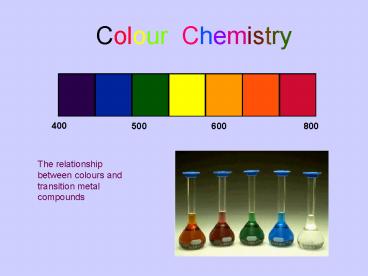Colour Chemistry - PowerPoint PPT Presentation
1 / 21
Title:
Colour Chemistry
Description:
In a complementary fashion, if the sample absorbed only orange, it would appear ... i) Separate metal and ligands high energy. ii) Co-ordinated Metal - ligand ... – PowerPoint PPT presentation
Number of Views:1997
Avg rating:5.0/5.0
Title: Colour Chemistry
1
Colour Chemistry
The relationship between colours and transition
metal compounds
2
Colour How We Perceive it
Removing a primary colour produces the
complimentary colour
White light can be made from the 3 primary
colours red, blue and green.
3
Colour wheel showing the colours which are
complementary to one another
4
Black White
When a sample absorbs light, what we see is the
sum of the remaining colours that strikes our
eyes.
If a sample absorbs all the wavelengths of
visible light, none reaches our eyes from that
sample. Consequently, it appears black.
If the sample absorbs no visible light, it is
white or colourless.
5
Absorption and Reflection
If the sample absorbs all but orange, the sample
appears orange.
Further, we also perceive orange colour when
visible light of all colours except blue
strikes our eyes. In a complementary fashion,
if the sample absorbed only orange, it would
appear blue blue and orange are said to be
complementary colours.
6
Light absorption Properties of Metal Complexes
Recording the absorption Spectrum
7
white light
Cu(H2O)62
8
white light
Potassium dichromate solution
9
Visible spectrum of violet Ti3(aq)
10
Crystal Field Theory
Model explaining bonding for transition metal
complexes
Basic idea ionic bonding between lone-pair
electrons and positive metal ion
11
Energetics
i) Separate metal and ligands high energy
ii) Co-ordinated Metal - ligand stabilized
iii) Destabilization due to ligand -d electron
repulsion
iv) Splitting due to octahedral field
12
Ligand-Metal Interaction
As the ligands approach the metal ion, the
lone-pair electrons are repelled by the d-orbital
electrons.
In an octahedral complex, d-orbitals aligned
along the octahedral axes will be affected the
most.
13
d-orbitals and ligand interaction
Ligands approach the metal
d-orbitals pointing directly at axis are affected
most by electrostatic interaction
d-orbitals not pointing directly at axis are
least affected (stabilized) by electrostatic
interaction
14
Splitting of the d-Orbitals
The energy gap is referred to as ? , the crystal
field splitting energy
The dz2 and dx2-y2 orbitals lie on the same axes
as ligand lone-pairs.
Therefore, there is a large, unfavorable
interaction between ligand lone-pairs electrons
in metal orbitals.
The dxy , dyx and dxz orbitals bisect the ligands
lone-pairs..
Therefore, there is a smaller repulsion between
ligand metal for these orbitals.
15
Electron Promotion
Consider one d-electron
If this absorbs energy from the visible spectrum
it can be promoted to the higher level
The remaining light is transmitted and this is
the colour that we see
16
Magnitude of CF Splitting
Colour of the Complex depends on magnitude of ?
- Metal Larger metal - larger ?
- Higher Oxidation State -
larger ?
- Ligand Spectrochemical series
- Cl- lt F- lt H2O lt NH3 lt en lt NO2- lt (N-bonded) lt
CN-
Weak field Ligand Low electrostatic interaction
small CF splitting.
High field Ligand High electrostatic
interaction large CF splitting.
17
Spectrochemical series Increasing ?
Cl- lt F- lt H2O lt NH3 lt en lt NO2- lt (N-bonded) lt
CN-
low energy
18
Octahedral, Tetrahedral Square Planar
Octahedral
Square planar
Tetrahedral
19
Ligand Field Theory
Lone-pair electrons of the ligand are donated
into empty orbitals of the metal
20
Ligand field theory combines many of the metals
orbitals with the ligand orbitals
Electrons can be promoted between molecular
orbitals using energy from the visible spectrum
as with crystal field theory
21
The End































